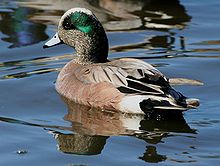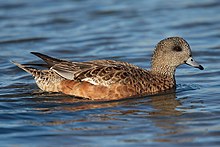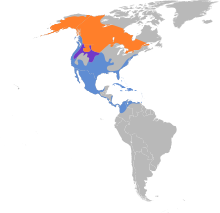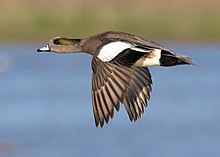American wigeon
| American wigeon | |
|---|---|

| |
| Male | |

| |
| Female | |
| Scientific classification | |
| Domain: | Eukaryota |
| Kingdom: | Animalia |
| Phylum: | Chordata |
| Class: | Aves |
| Order: | Anseriformes |
| Family: | Anatidae |
| Genus: | Mareca |
| Species: | M. americana
|
| Binomial name | |
| Mareca americana (Gmelin, JF, 1789)
| |

| |
Breeding summer visitor Breeding resident Nonbreeding winter visitor
| |
| Synonyms | |
|
Anas americana Gmelin, 1789 | |
The American wigeon (Mareca americana), also known as the baldpate, is a species of
Taxonomy
The American wigeon was
An alternative common name is the "baldpate" due to the whitish crown and forehead of the male bird.[9]
Description

The American wigeon is a medium-sized bird; it is larger than a teal but smaller than a pintail. In silhouette, the wigeon can be distinguished from other dabblers by its round head, short neck, and small bill.[10] It is 42–59 cm (17–23 in) long, with a 76–91 cm (30–36 in) wingspan and a weight of 512–1,330 g (1.129–2.932 lb).[11][12][13] This wigeon has two adult molts per year and a juvenile molt in the first year, as well.[11]
The breeding male (drake) is a striking bird with a mask of green feathers around its eyes and a cream-colored cap running from the crown of his head to his bill. This white patch gives the wigeon its other common name, baldpate (pate is another word for head).[14] His belly is also white.[15] In flight, drakes can be identified by the large white shoulder patch on each wing. These white patches flash as the birds bank and turn. In nonbreeding (eclipse) plumage, the drake looks more like the female.[10]
The hens are much less conspicuous, having primarily gray and brown plumage. Both sexes have a pale blue bill with a black tip, a white belly, and gray legs and feet.[10] The wing patch behind the speculum is gray. They can be distinguished from most ducks, apart from Eurasian wigeon, by shape. However, that species has a darker head and all-grey underwing. The head and neck coloring of the female is different from the Eurasian wigeon.[15] She nests on the ground, near water and under cover, and lays 6–12 creamy white eggs. Flocks often contain American coots.[11]
The American wigeon is a noisy species, and in the field can often be identified by its distinctive calls. Drakes produce a three-note whistle, while hens emit hoarse grunts and quacks.[10] The male whistle makes a wheezy whoee-whoe-whoe, whereas the female has a low growl qua-ack.
Distribution and habitat

It is common and widespread, breeding in all but the extreme north of
This
In 2009, an estimated 2.5 million breeding wigeons were tallied in the traditional survey area—a level just below the 1955–2009 average. In recent decades, wigeon numbers have declined in the Prairie Pothole Region of Canada and increased in the interior and west coast of Alaska. The American wigeon is often the fifth-most commonly harvested duck in the United States, behind the mallard, green-winged teal, gadwall, and wood duck.[10]
Behavior


The American wigeon is a bird of open
Breeding
Breeding begins in April-May. The nest is a depression on dry ground, often some distance from water. It is lined with grass and down and is hidden in vegetation. The clutch is 7–9, cream-colored eggs, which measure on average 52.9 mm × 37.5 mm (2.08 in × 1.48 in) and weigh 43 g (1.5 oz). They are incubated for 23–25 days by the female only. The male usually deserts the female before the end of the incubation period. The young are
References
- ^ . Retrieved 12 November 2021.
- ^ Gmelin, Johann Friedrich (1789). Systema naturae per regna tria naturae : secundum classes, ordines, genera, species, cum characteribus, differentiis, synonymis, locis (in Latin). Vol. 1, Part 2 (13th ed.). Lipsiae [Leipzig]: Georg. Emanuel. Beer. p. 526.
- Daubenton, Louis-Jean-Marie (1765–1783). "Le canard jensen de Louisiane". Planches Enluminées D'Histoire Naturelle. Vol. 10. Paris: De L'Imprimerie Royale. Plate 955.
- ^ Pennant, Thomas (1785). Arctic Zoology. Vol. 2. London, United Kingdom: Printed by Henry Hughs. pp. 567–568, No. 502.
- ^ Mayr, Ernst; Cottrell, G. William, eds. (1979). Check-List of Birds of the World. Vol. 1 (2nd ed.). Cambridge, Massachusetts: Museum of Comparative Zoology. p. 463.
- ^ Stephens, James Francis (1824). General Zoology, or Systematic Natural History, by the Late George Shaw. Vol. 12 Part 2. London: Printed for G. Kearsley. p. 130.
- ^ Rasmussen, Pamela, eds. (January 2022). "Screamers, ducks, geese & swans". IOC World Bird List Version 12.1. International Ornithologists' Union. Retrieved 4 July 2022.
- ISBN 978-1-4081-2501-4.
- ^ . Retrieved 4 July 2022.
- ^ a b c d e f g "The American Wigeon". Ducks Unlimited. May–June 2010. Archived from the original on 2011-12-15. Retrieved 2010-08-08.
- ^ a b c d e f g Floyd, T. (2008). Smithsonian Field Guide to the Birds of North America. New York: Harper Collins.
- ^ "American Wigeon". All About Birds.
- ISBN 978-0-8493-4258-5.
- ^ "Baldpate | bird". Encyclopedia Britannica. Retrieved 2021-06-17.
- ^ a b c d Dunn, J.; Alderfer, J. (2006). National Geographic Field Guide to the Birds of North America (5th ed.).
- ^ Clements, James (2007). The Clements Checklist of the Birds of the World. Cornell University Press, Ithaca.
- ISSN 0007-0335.
- ^ Ornithology, British Trust for (2015-04-07). "American Wigeon". BTO - British Trust for Ornithology. Retrieved 2024-05-25.
Sources
- Harrop, A. (1994). "Field identification of American Wigeon". Birding World. 7: 50–56.
- Jiquet, F. (1999). "Photo forum: Hybrid American Wigeons". Birding World. 12: 247–252.
- Larkin, P. (2000). "Eyelid colour of American Wigeon". British Birds. 93: 39–40.
- Madge, Steve; Burn, Hilary (1988). Waterfowl: an Identification Guide to the Ducks, Geese, and Swans of the World. Boston: Houghton Mifflin. ISBN 0-395-46727-6.
- Olson, Storrs L.; James, Helen F.; Meister, C. A. (1981). "Winter field notes and specimen weights of Cayman Island birds". Bulletin of the British Ornithologists' Club. 101 (3): 339–346. hdl:10088/6535.
- Votier, S. C.; Harrop, A. H. J.; Denny, M. (2003). "A review of status and identification of American Wigeon in Britain and Ireland". British Birds. 96: 2–22.
- Cox, Cameron; Barry, Jessie. "Aging of American and Eurasian Wigeons in female-type plumages" (PDF). Birding. 37 (2): 156–164. Archived from the original (PDF) on 2012-10-19. Retrieved 2011-10-09.
External links
- American Wigeon Species Account – Cornell Lab of Ornithology
- American Wigeon - Anas americana - USGS Patuxent Bird Identification InfoCenter
- "American Wigeon media". Internet Bird Collection.
- American Wigeon photo gallery at VIREO (Drexel University)
- Interactive range map of Anas americana at IUCN Red List maps

